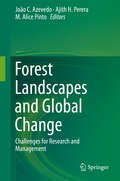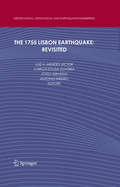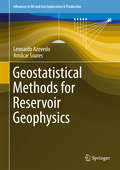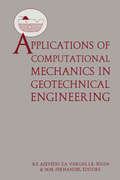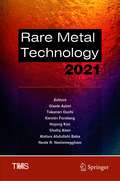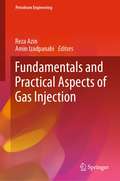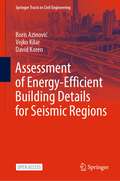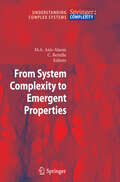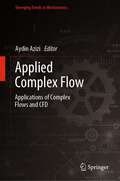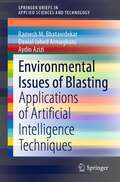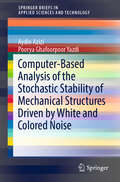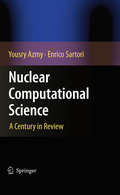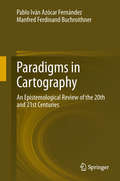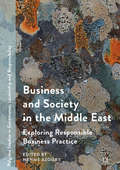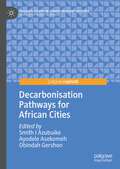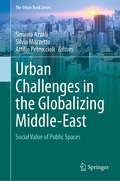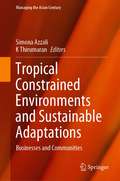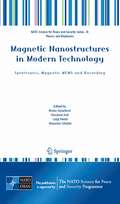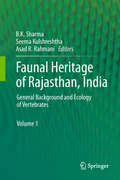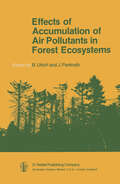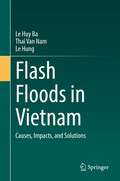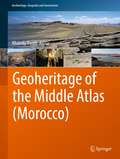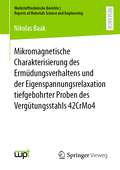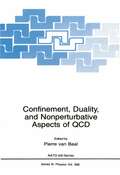- Table View
- List View
Forest Landscapes and Global Change: Challenges for Research and Management
by João C. Azevedo Ajith H. Perera M. Alice PintoClimate change, urban sprawl, abandonment of agriculture, intensification of forestry and agriculture, changes in energy generation and use, expansion of infrastructure networks, habitat destruction and degradation, and other drivers of change occur at increasing rates. They affect patterns and processes in forest landscapes, and modify ecosystem services derived from those ecosystems. Consequently, rapidly changing landscapes present many new challenges to scientists and managers. While it is not uncommon to encounter the terms “global change” and “landscape” together in the ecological literature, a global analyses of drivers of change in forest landscapes, and their ecological consequences have not been addressed adequately. That is the goal of this volume: an exploration of the state of knowledge of global changes in forested landscapes with emphasis on causes and effects, and challenges faced by researchers and land managers. Initial chapters identify and describe major agents of landscape change: climate, fire, and human activities. The next series of chapters address implications of changes on ecosystem services, biodiversity conservation and carbon flux. A chapter that describes methodologies of detecting and monitoring landscape changes is presented followed by chapter that highlights the many challenges forest landscape managers face amidst of global change. Finally, we present a summary and a synthesis of the main points presented in the book. Each chapter will contain the individual research experiences of chapter authors, augmented by review and synthesis of global scientific literature on relevant topics, as well as critical input from multiple peer reviewers.
The 1755 Lisbon Earthquake: Revisited (Geotechnical, Geological and Earthquake Engineering #7)
by João Azevedo A. Ribeiro Luiz Mendes-Victor Carlos Sousa OliveiraThe 1755 earthquake and tsunami were influential not only in Portugal but in all European and North African countries where the devastating effects were felt. The entire world was deeply impressed and the discussion of its causes generated a large amount of scientific and metaphysical speculation. It inspired philosophers, poets and writers. The socio-economic consequences of the event were great and affected the future organization and development of Portugal. The possibility of a similar occurence urges society and the scientific community to reflect on its lessons. AudienceThis work is of interest to experts in seismology, earthquake engineering, civil protection, urban planning and it is a reference book for doctoral students.
Geostatistical Methods for Reservoir Geophysics (Advances in Oil and Gas Exploration & Production)
by Leonardo Azevedo Amílcar SoaresThis book presents a geostatistical framework for data integration into subsurface Earth modeling. It offers extensive geostatistical background information, including detailed descriptions of the main geostatistical tools traditionally used in Earth related sciences to infer the spatial distribution of a given property of interest. This framework is then directly linked with applications in the oil and gas industry and how it can be used as the basis to simultaneously integrate geophysical data (e.g. seismic reflection data) and well-log data into reservoir modeling and characterization. All of the cutting-edge methodologies presented here are first approached from a theoretical point of view and then supplemented by sample applications from real case studies involving different geological scenarios and different challenges. The book offers a valuable resource for students who are interested in learning more about the fascinating world of geostatistics and reservoir modeling and characterization. It offers them a deeper understanding of the main geostatistical concepts and how geostatistics can be used to achieve better data integration and reservoir modeling.
Applications of Computational Mechanics in Geotechnical Engineering
by R. F. Azevedo E. A. Vargas Et Et AlThe development of constitutive relations for geotechnical materials, with the help of numerical models, have increased notably the ability to predict and to interpret mechanical behaviour of geotechnical works. These proceedings cover the applications of computational mechanics in this area.
Rare Metal Technology 2021 (The Minerals, Metals & Materials Series)
by Gisele Azimi Takanari Ouchi Kerstin Forsberg Hojong Kim Shafiq Alam Alafara Abdullahi Baba Neale R. NeelamegghamThis collection presents papers from a symposium on extraction of rare metals as well as rare extraction processing techniques used in metal production. It covers metals essential for critical modern technologies including electronics, electric motors, generators, energy storage systems, and specialty alloys. Rare metals are the main building blocks of many emerging critical technologies and have been receiving significant attention in recent years. Much research in academia and industry is devoted to finding novel techniques to extract critical and rare metals from primary and secondary sources. The technologies that rely on critical metals are dominating the world, and finding a way to extract and supply them effectively is highly desirable and beneficial. Rapid development of these technologies entails fast advancement of the resource and processing industry for their building materials. Authors from academia and industry exchange knowledge on developing, operating, and advancing extractive and processing technologies. Contributions cover rare-earth elements (magnets, catalysts, phosphors, and others), energy storage materials (lithium, cobalt, vanadium, graphite), alloy elements (scandium, niobium, titanium), and materials for electronics (gallium, germanium, indium, gold, silver). The contributions also cover various processing techniques in mineral beneficiation, hydrometallurgy, separation and purification, pyrometallurgy, electrometallurgy, supercritical fluid extraction, and recycling (batteries, magnets, electrical and electronic equipment).
Fundamentals and Practical Aspects of Gas Injection (Petroleum Engineering)
by Reza Azin Amin IzadpanahiThis book covers different aspects of gas injection, from the classic pressure maintenance operation to enhanced oil recovery (EOR), underground gas storage (UGS), and carbon capture and storage (CCS). The authors detail the unique characteristics and specific criteria of each application, including: material balance equationsphase behaviourreservoir engineeringwell designoperating aspectssurface facilitiesenvironmental issues Examples, data, and simulation codes are provided to enable the reader to gain an in-depth understanding of these applications. Fundamentals and Practical Aspects of Gas Injection will be of use to practising engineers in the fields of reservoir engineering, and enhanced oil recovery. It will also be of interest to researchers, academics, and graduate students working in the field of petroleum engineering.
Assessment of Energy-Efficient Building Details for Seismic Regions (Springer Tracts in Civil Engineering)
by Boris Azinović Vojko Kilar David KorenThis open access book presents a methodology for the assessment of structural building details, taking into account the contemporary guidelines for earthquake-resistant and energy-efficient buildings. A review of structural details for energy-efficient buildings revealed that in some cases the structural system is interrupted, leading to solutions which are not suitable for earthquake-prone regions. Such typical examples would be the use of thermal insulation under the building foundation and reduction of the load-bearing elements’ dimensions – also at the potential locations of plastic hinges which are crucial for the dissipation of seismic energy. The proposed methodology of assessment favours a collaboration of architects, engineers, contractors and investors in the early stage of building design. By this the methodology enables efficient decision-making and contributes to a selection of optimal building structural details.The book starts by presenting the typical structural details of the thermal envelope of energy-efficient buildings together with the scientific background required for understanding the process of detail development from all the relevant aspects. Over 20 examples of most frequent details are described and analysed to raise awareness of the importance of earthquake resistance, sustainability, energy-efficiency and thermal comfort for users.
Emergent Properties in Natural and Artificial Dynamical Systems (Understanding Complex Systems)
by Moulay Aziz-Alaoui Cyrille BertelleAn important part of the science of complexity is the study of emergent properties arising through dynamical processes, in various natural and artificial systems. This book presents multidisciplinary approaches for creating and modeling representations of complex systems, and a variety of methods for extracting emergent structures. Offering bio-complexity examples, the coverage extends to self organization, synchronization, stability and robustness. The contributors include researchers in physics, engineering, biology and chemistry.
From System Complexity to Emergent Properties (Understanding Complex Systems)
by Moulay Aziz-Alaoui Cyrille BertelleEmergence and complexity refer to the appearance of higher-level properties and behaviours of a system that obviously comes from the collective dynamics of that system's components. These properties are not directly deducible from the lower-level motion of that system. Emergent properties are properties of the "whole'' that are not possessed by any of the individual parts making up that whole. Such phenomena exist in various domains and can be described, using complexity concepts and thematic knowledges. This book highlights complexity modelling through dynamical or behavioral systems. The pluridisciplinary purposes, developed along the chapters, are able to design links between a wide-range of fundamental and applicative Sciences. Developing such links - instead of focusing on specific and narrow researches - is characteristic of the Science of Complexity that we try to promote by this contribution.
Applied Complex Flow: Applications of Complex Flows and CFD (Emerging Trends in Mechatronics)
by Aydin AziziThis book presents improved numerical techniques and applied computer-aided simulations as a part of emerging trends in mechatronics in all areas related to complex fluids, with particular focus on using a combination of modeling, theory, and simulation to study systems that are complex due to the rheology of fluids (i.e., ceramic pastes, polymer solutions and melts, colloidal suspensions, emulsions, foams, micro-/nanofluids, etc.) and multiphysics phenomena in which the interactions of various effects (thermal, chemical, electric, magnetic, or mechanical) lead to complex dynamics. The areas of applications span materials processing, manufacturing, and biology.
Environmental Issues of Blasting: Applications of Artificial Intelligence Techniques (SpringerBriefs in Applied Sciences and Technology)
by Aydin Azizi Danial Jahed Armaghani Ramesh M. BhatawdekarThis book gives a rigorous and up-to-date study of the various AI and machine learning algorithms for resolving environmental challenges associated with blasting. Blasting is a critical activity in any mining or civil engineering project for breaking down hard rock masses. A small amount of explosive energy is only used during blasting to fracture rock in order to achieve the appropriate fragmentation, throw, and development of muck pile. The surplus energy is transformed into unfavourable environmental effects such as back-break, flyrock, air overpressure, and ground vibration. The advancement of artificial intelligence and machine learning techniques has increased the accuracy of predicting these environmental impacts of blasting. This book discusses the effective application of these strategies in forecasting, mitigating, and regulating the aforementioned blasting environmental hazards.
Computer-Based Analysis of the Stochastic Stability of Mechanical Structures Driven by White and Colored Noise (SpringerBriefs in Applied Sciences and Technology)
by Aydin Azizi Poorya Ghafoorpoor YazdiThis book provides a concise introduction to the behavior of mechanical structures and testing their stochastic stability under the influence of noise. It explains the physical effects of noise and in particular the concept of Gaussian white noise. In closing, the book explains how to model the effects of noise on mechanical structures, and how to nullify / compensate for it by designing effective controllers.
Nuclear Computational Science: A Century in Review
by Yousry Azmy Enrico SartoriNuclear engineering has undergone extensive progress over the years. In the past century, colossal developments have been made and with specific reference to the mathematical theory and computational science underlying this discipline, advances in areas such as high-order discretization methods, Krylov Methods and Iteration Acceleration have steadily grown. Nuclear Computational Science: A Century in Review addresses these topics and many more; topics which hold special ties to the first half of the century, and topics focused around the unique combination of nuclear engineering, computational science and mathematical theory. Comprising eight chapters, Nuclear Computational Science: A Century in Review incorporates a number of carefully selected issues representing a variety of problems, providing the reader with a wealth of information in both a clear and concise manner. The comprehensive nature of the coverage and the stature of the contributing authors combine to make this a unique landmark publication. Targeting the medium to advanced level academic, this book will appeal to researchers and students with an interest in the progression of mathematical theory and its application to nuclear computational science.
Paradigms in Cartography: An Epistemological Review of the 20th and 21st Centuries
by Pablo Iván Azócar Fernández Manfred Ferdinand BuchroithnerIn this book the main trends, concepts and directions in cartography and mapping in modernism and post-modernism are reviewed. Philosophical and epistemological issues are analysed in cartography from positivist-empiricist, neo-positivist and post-structuralist stances. In general, in cartography technological aspects have been considered as well as theoretical issues. The aim is to highlight the epistemological and philosophical viewpoint during the development of the discipline. Some main philosophers who have been influential for contemporary thinking such as Immanuel Kant, Ludwig Wittgenstein, Karl Popper and Bertrand Russell, are considered. None of these philosophers wrote about cartography directly (excepting Kant), but their philosophies are related to cartography and mapping issues. The book also analyses the concept of paradigm or paradigm shift coined by Thomas Kuhn, who applied it to the history of science. Different cartographic trends that have arisen since the second half of the twentieth century are analysed according to this important concept which is implicit inside the scientific or disciplinary communities. Further, the authors analyse the position of cartography in the context of the sciences and other disciplines, adopting a positivistic point of view. Additionally, they review current trends in cartography and mapping in the context of information and communication technologies in a post-modernistic or post-structuralistic framework. Thus, since the 1980s and 1990s, new mapping concepts have arisen which challenge the discipline’s traditional map conceptions.
Business and Society in the Middle East: Exploring Responsible Business Practice (Palgrave Studies in Governance, Leadership and Responsibility)
by Nehme AzouryThis book discusses the unique relationship between societies and businesses in the Mediterranean region, with contributions from public figures and academics from Middle Eastern and Arab societies, as well as from North America and Europe. This blend of expertise and knowledge focuses on common business practices and their effect on society in Mediterranean countries, and aims to create a bridge between the two. Considering the cultural, social, political, legal and economic impacts and variety, Business and Society in the Middle East is a contemporary and authentic view of how local and traditional aspects of society dictate diversity and homogeneity within businesses.
Decarbonisation Pathways for African Cities (Palgrave Studies in Climate Resilient Societies)
by Smith I Azubuike Ayodele Asekomeh Obindah GershonThis book examines the pathways to decarbonising African cities, structured around strategies and applications in renewable energy, waste management, healthcare, telecommunication, education and governance reconfigurations for Petro-cities. Throughout the book the authors highlight infrastructural, governance and policy approaches to drive decarbonisation. Opening with chapters focused on propositions for solar urban planning and scope for decarbonisation in waste management the book then moves on to examine innovative strategies for a low-carbon healthcare sector. The authors then discuss the use of hybrid power systems at remote telecommunication sites, their deployment on university campuses, and how this can be optimised to reduce carbon emissions. Further chapters explore government, private sector and civil society actions for decarbonising Kenyan cities and an overview of the political economic choices for decarbonising Petro-cities. Finally, closing chapters propose mechanisms for translating COP26 takeaways to decarbonisation policies and a low-carbon framework for African cities.
Urban Challenges in the Globalizing Middle-East: Social Value of Public Spaces (The Urban Book Series)
by Simona Azzali Silvia Mazzetto Attilio PetruccioliThis publication aims to investigate the nature of social life in public and urban spaces in the cities of the Middle East, considering the value of environmental approaches. It aims to develop a better understanding of the patterns of social interactions and activities in public places, which have been influenced by cultural heritage values.Sustainable and livable open spaces can help in improving living conditions in cities. Public spaces are relevant as they satisfy many human needs. In public spaces, people interact and meet; people with different cultures and social backgrounds can communicate and learn from each other in social and spontaneous ways. However, decision-makers tend to forget the value of public spaces, especially in the absence of a national regulatory framework in emerging globalized cities.The book provides a multi-disciplinary approach in reading the characteristics and values of public spaces in the emerging cities of the Middle East.
Tropical Constrained Environments and Sustainable Adaptations: Businesses and Communities (Managing the Asian Century)
by Simona Azzali K ThirumaranThis book investigates resource-constrained environments in the tropics and subtropics where people’s lives and businesses are affected, and adaptations occur periodically. Constrained environments are unique territories characterised by challenging circumstances, limited land and natural resources. They can be places with a small municipal boundary or cities in which parts around them may be consumed by ocean, bay or mountains. Those places face hard physical boundaries like coastlines and mountains, which in addition to policy decisions that may limit height or density, can also serve to limit capacity for expansion. Successful communities and businesses tend to survive in a changing environment given their strong intuitive and forward-looking adaptations.This book delves into the role of urban planning and design in the promotion of business and adaptations of people and communities. Additionally, the focus takes into account impact analysis and the effects of an expanding populations, including growing migrant flows, and business needs on the built environment of land-constrained territories
Magnetic Nanostructures in Modern Technology: Spintronics, Magnetic MEMS and Recording (NATO Science for Peace and Security Series B: Physics and Biophysics)
by Bruno Azzerboni Giovanni Asti Luigi Pareti Massimo GhidiniIn this book, a team of outstanding scientists in the field of modern magnetic nanotechnologies illustrates the state-of-the-art in several areas of advanced magneto-electronic devices, magnetic micro-electromechanical systems and high density information storage technologies. Providing a unique source of information for the young physicist, chemist or engineer, the book also serves as a crucial reference for the expert scientist and the teacher of advanced university courses.
Faunal Heritage of Rajasthan, India: General Background and Ecology of Vertebrates
by B. K. Sharma, Seema Kulshreshtha and Asad R. RahmaniThis is the first ever monumental and scientific documentation of the faunal wealth of the Indian Desert state of Rajasthan. This volume, the first of two, provides background on Rajasthan and covers species diversity and distribution of fauna. A scholarly contribution to the field of knowledge, it provides novel and vital information on the vertebrate faunal heritage of India’s largest state. Broadly falling under the Indo-Malaya Ecozone, the three major biomes of Rajasthan include deserts and xeric shrublands, tropical and subtropical dry broadleaf forests, and tropical and subtropical moist broadleaf forests. The corresponding ecoregions to the above biomes are, respectively, the Thar Desert and northwestern thorn scrub forests, the Khathiar-Gir dry deciduous forests, and the Upper Gangtic Plains moist deciduous forests. Contrary to popular belief, the well-known Thar or Great Indian Desert occupies only a part of the state. Rajasthan is diagonally divided by the Aravalli mountain ranges into arid and semi-arid regions. The latter have a spectacular variety of highly diversified and unique yet fragile ecosystems comprising lush green fields, marshes, grasslands, rocky patches and hilly terrains, dense forests, the southern plateau, fresh water wetlands, and salt lakes.Apart from the floral richness, there is faunal abundance from fishes to mammals. In this volume, the various flagship and threatened species are described in the 24 chapters penned by top notch wildlife experts and academics. The world famous heronry, tiger reserves, wildlife sanctuaries and some threat-ridden biodiversity rich areas shall certainly draw the attention of readers from around the world.
Effects of Accumulation of Air Pollutants in Forest Ecosystems: Proceedings of a Workshop held at Göttingen, West Germany, May 16–18, 1982
by B. Ulrich and J. PankrathThis volume is based on a workshop on "Effects of accumulation of air pollutants in forest ecosystems'; held in GOttingen, Federal Republic of Germany, from May 16-18, 1982. This work'shop was initiated and sponsored by the Environmental Agency of the Federal Republic of Germany (project officer: Dr. J. Pankrath) as part of a research contract (project leader: Dr. B. Ulrich). THE PROBLEM SEEN UNDER THE ASPECT OF ADMINISTRATION The problem of forest damage caused by air pollution is not new in Europe. Already in 1983 a comprehensive report from Schroeder and Reuss about vegetation damages by fume in the Harz mountains was published. In 1923, Prof. Dr. Julius Stocklasa of the Bohemian Technical Highschool in Prague was concerned with research of toxical effects of sulphur dioxide in his publication "The damage of vegetation by flue gas and exhalations of facili ties". This comprehensive and instructive work concludes with the sentence: "It is already high time for the governments of all cultural states to take legal, police and private measures in order to prevent damage by flue gases". In the neighbourhood of industries with high gaseous and dust emissions damages have been shown to occur for a long timei these deleterious effects have influenced the growth of trees and in extreme cases have even caused their early death.
Flash Floods in Vietnam: Causes, Impacts, and Solutions
by Le Huy Ba Thai Van Nam Le HungThis book discusses the threats and impacts of flash floods in Vietnam on environmental, human, and socio-economic resources, and covers monitoring, forecasting, warning, urgent action plans, and prevention solutions. While the work focuses on cases in Vietnam, it is applicable to many regions in the world that experience flash flooding as a common occurrence. Through data collection, field surveys, and investigational statistics from a specialized group of authors, the book provides comprehensive background knowledge on flash floods, and a flash flood hazard map using remote sensing and GIS techniques that can be used to assess the likelihood and potential impacts of flash floods before vulnerable areas and populations can be threatened. The intended audience of this manuscript is people interested in the fields of weather, environment, and natural disasters. It will serve as a reference for environmental managers, administrators of disaster planning, and extreme weather scientists.
Geoheritage of the Middle Atlas (Geoheritage, Geoparks and Geotourism)
by Khaoula BaadiThis book is a condensed summary of a broad spectrum of the geological heritage of the Middle Atlas. It has the particularity of proposing an in-depth synthesis and a critical review of the geoheritage of the region. The book addresses the issues related to geoheritage and methodologies for the selection, inventory, assessment and preservation of geosites. It reviews the state of the art of geoheritage in Morocco, particularly in the Middle Atlas, in order to identify geosites with rare and unique geological features. The book presents a detailed study of lithostratigraphic and sedimentological heritage as geosites witnessing at different spatial and temporal scales the evolution and the stratigraphic, sedimentological and paleogeographic history of the Middle Atlas range. It also presents the paleontological heritage of vertebrates by reviewing the discoveries of paleontological sites and their risks in order to present its conservation plans. It also addresses the hydric and fluvial heritage by presenting the potential of water resources and the impact of climate change on the latter. Furthermore, it highlights the karst heritage by exposing an inventory of exo- and endokarst geosites in order to emphasize some unique sites on a national and African scale as well as revealing the underground biodiversity related to this heritage. Finally, it proposes a presentation of the volcanic heritage in order to assess the volcanic geosites that testify to the strombolian, phreatomagmatic and Hawaiian dynamism of the region. The book is mainly intended for researchers, geologists and specialists of the Moroccan Middle Atlas region wishing to acquire a broad multidisciplinary or even transdisciplinary knowledge. It will also be accessible to a non-initiated public, interested in the richness of the Moroccan geoheritage, as well as to Moroccan territorial authorities (High Commission for Water and Forests, Ministry of Tourism, National Institute of Archaeology and Heritage Sciences, etc.) who can benefit from it in the perspective of their strategies of preservation of the national geological heritage. This work will be an example for geoscientists, on an African scale, of a valorization of territorial geological heritage.
Mikromagnetische Charakterisierung des Ermüdungsverhaltens und der Eigenspannungsrelaxation tiefgebohrter Proben des Vergütungsstahls 42CrMo4 (Werkstofftechnische Berichte │ Reports of Materials Science and Engineering)
by Nikolas BaakNikolas Baak befasst sich mit der Qualifizierung mikromagnetischer Methoden zur Bewertung der durch Tiefbohren erzeugten Randzonen hinsichtlich ihrer Oberflächenintegrität und deren Einfluss auf das Ermüdungsverhalten. Dabei wird das Ziel verfolgt, durch den Bohrprozess einen vorteilhaften Eigenspannungszustand zu erreichen. Beim hier eingesetzten Einlippen-Tiefbohren kommt es aufgrund des asymmetrischen Werkzeugaufbaus zu einer Art Festwalzprozess. Dadurch werden sowohl sehr hohe Oberflächengüten, als auch der gewünschte Druckeigenspannungszustand erzeugt. Da die meisten Verfahren zur Bestimmung der Oberflächenintegrität entweder zerstörend sind oder auch einen freien Zugang zur Oberfläche benötigen, werden hier zerstörungsfreie Prüfverfahren dafür ertüchtigt, die Oberflächenintegrität sowie den Ermüdungszustand der Bauteile zu bestimmen. Für beide hier betrachteten mikromagnetischen Verfahren, einerseits die Barkhausenrauschen-Analyse und andererseits die Wirbelstromprüfung, werden speziell angefertigte Sensoren, welche das Messsignal an der Innenseite der Bohrung detektieren können, verwendet. Die Messdaten der mikromagnetischen Verfahren werden mit den etablierten Verfahren zur Bestimmung der Oberflächenintegrität, wie bspw. Röntgendiffraktometrie, korreliert.
Confinement, Duality, and Nonperturbative Aspects of QCD (Nato Science Series B: #368)
by Pierre Van BaalProceedings of a NATO ASI and Isaac Newton Institute Workshop held in Cambridge, UK, June 23-July 4, 1997
